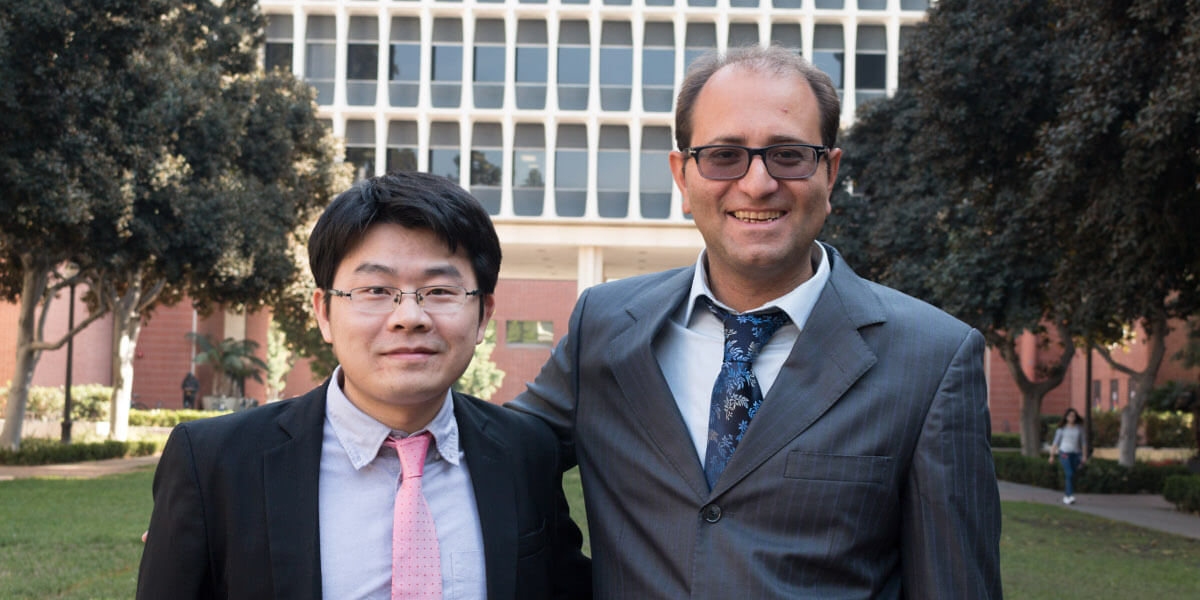
Qiming Wang and Mahdi Soltanolkotabi. Photo/USC Viterbi
Computers that can think like a human. Armor that can heal itself.
With the help of two USC Viterbi professors, winners of the Air Force’s Young Investigator Award, these technologies will be here before we know it.
As part of the Air Force’s Young Investigator Research Program (YIP), the Air Force Office of Scientific Research (AFOSR) provides support to young faculty members by awarding research grants to scientists and engineers who show exceptional ability and promise. This year, two members of the Viterbi School of Engineering faculty were among the 43 awardees selected to receive a $450,000 three-year grant: Assistant Professor Mahdi Soltanolkotabi, of the Ming Hsieh Department of Electrical Engineering and Department of Computer Science, and Assistant Professor Qiming Wang, of the Sonny Astani Department of Civil and Environmental Engineering.
Mahdi Soltanolkotabi
Soltanolkotabi, a member of both the Machine Learning Center and the Center for Cyber-Physical Systems and the Internet of Things, was recognized for his work on Learning Data Representations.
This allows computers to construct succinct and interpretable representations from high-dimensional data so as to learn new skills and better interpret text, video, and audio. Soltanolkotabi achieves this through novel data factorization and embedding, which is a process in which very large sets of data are mapped into representations that are easier for a computer to make sense of.
“Learning data representations that help identify and disentangle the underlying explanatory factors hidden in data is fundamental to our ability to extract new and deep insights from data. Consider something like a self-driving car. The computer not only needs to see moving objects around it, but also to differentiate between the categories,” said Soltanolkotabi. “Another car, a pedestrian, a bicyclist – they all must be recognized in different ways on the road, and this technology helps the computer do that.”
Another example is a computer’s ability to comprehend language. This is much harder than simply uploading every word in the English language into a computer’s memory and sitting back. Language, even sometimes in the Twitter-dominated world of today, contains nuance and relies on context. Consider this analogy: King is to Male as Queen is to what? To a human, the answer is obviously female. But without data embedding, the computer might decide the answer is “Freddie Mercury.”
This strategy can be applied to a wide variety of disciplines that require interpreting large data sets, which in today’s data-driven world, encompasses more and more fields every day. In fact, data sets like the human genome or retail transactions at Walmart dwarf any human language in terms of information and nuance. The main goal is to get computers better at not only predicting based on data but actually interpreting the data like a human – a major step in moving AI and Big Data forward.
Qiming Wang
Wang, who leads the Materials and Structures Laboratory, is developing a self-healable, 3-D printed material that can be used to create lightweight armor or aircraft wings.
If damaged or fractured, self-healing materials are able to reform their structure and restore their mechanical properties. However, the manufacturing method for these materials is limited, making it impossible to form them into lightweight, mesh-like structures. This is because no existing self-healing material is able to undergo photopolymerization, a process used in 3-D printing in which light causes the molecules to link, forming polymers and the rigid structure.
Wang’s novel material will be capable of both rapid self-healing and 3-D printing, resulting in a low-density, high mechanically efficient material that will be able to restore stiffness, strength and fracture resistance after multiple cycles of fractures and healing.
“The mechanism behind it is that it has dynamic bonds inside of it,” said Wang. “For example, in chemistry, you have covalent and ionic bonds. With covalent bonds, when you break it, it cannot go back together. But, with ionic bonds, if you break it, it can go back.”
The mesh-like structure will also act as a padding, dissipating the force and lessening the impact on the aircraft or the soldier. After the material is crushed and the beams that make up the mesh have fractured, after a certain amount of time, the bonds in the material will reform. Wang’s current iteration of the material is able to heal after a few hours, but a major aspect of his study is to examine factors behind the self-healing mechanism and find ways to improve.
“The major task for this proposal is to study the self-healing behavior of these cellular structures,” Wang said. “What is the key factor to control this self-healing time and self-healing efficiency? Different factors may be how you put it back together, how you control the material composition inside of it and how you control the external healing environment like temperature.”
Published on January 12th, 2018
Last updated on September 16th, 2020











